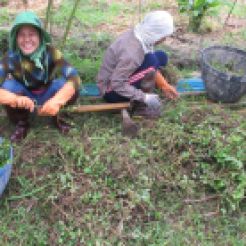As a young site develops, growing vegetation will naturally create more shade and this will greatly reduce the growth of unwanted weeds. But there are a few slow and simple steps we can take at the start of the project to reduce the effort required in controlling weeds without herbicides.
In a open site with decent, non degraded soil, the strategy we found most successful is to seed or transplant pinto peanut (arachis pintoi) in an aggressive and extensive way, and mow the area often until the peanut is established.
In the photos you can see how plant grows, here we have taken shoots from an established area to transplant and colonise a young new patch of agro-forest.
It is one of the first things we will get to, once all major jobs that require earth moving machinery have been completed.
This strategy is not sufficient in degraded sites, where there is a lack of nutrients in the soil and weeds tend to less rampant, the pinto peanut alone might also struggle. More importance here is given to loosening of the soil to allow for better water retention, nitrogen fixing and soil texture improvement through the composting or mulching of own produced biomass.
For a quick non-labour intensive and food-producing solution of ground cover, nitrogen fixing, soil loosening and biomass production, what I think works best is a combination of papaya, moringa, pigeon pea and madre de cacao. All are fast growing and the legumes are nitrogen fixing, and can be removed relatively easily, once the climax species are growing and are needing more space and sunlight.
To the above can be added climbing legumes which require little care, in the tropics the easiest choice is in my opinion hopi red lima. Another interesting climber that can be used at this early stage for easy food is chayote. For quick food producing ground cover, if the soil can sustain it, very little beats pumpkin.
At the edges of the site, banana, edible bamboo and cassava can be useful, but beware, they are very aggressive in their absorption of nutrients and are best kept away from plants that are not quite so efficient. Any pinto peanut added to the system at this early stage will also prosper more easily without care.
Aside for a (very easy) bit of occasional work managing the climbers, and a bit of targeted strimming (if necessary), when planted at the beginning of the rainy season, the whole system can be left alone for months.





